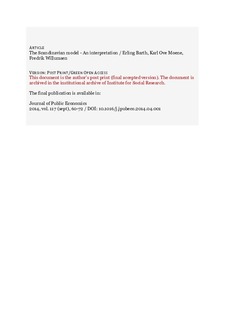| dc.contributor.author | Barth, Erling | |
| dc.contributor.author | Moene, Karl Ove | |
| dc.contributor.author | Willumsen, Fredrik | |
| dc.date.accessioned | 2018-01-09T12:25:33Z | |
| dc.date.available | 2018-01-09T12:25:33Z | |
| dc.date.created | 2014-12-04T10:07:02Z | |
| dc.date.issued | 2014 | |
| dc.identifier.citation | Journal of Public Economics. 2014, 117 (Sept.), 60-72. | |
| dc.identifier.issn | 0047-2727 | |
| dc.identifier.uri | http://hdl.handle.net/11250/2476408 | |
| dc.description.abstract | The small open economies in Scandinavia have for long periods had high work effort, small wage differentials, high productivity, and a generous welfare state. To understand how this might be an economic and political equilibrium we combine models of collective wage bargaining, creative job destruction, and welfare spending. The two-tier system of wage bargaining provides microeconomic efficiency and wage compression. Combined with a vintage approach to the process of creative destruction we show how wage compression fuels investments, enhances average productivity and increases the mean wage by allocating more of the work force to the most modern activities. Finally, we show how the political support of welfare spending is fueled by both a higher mean wage and a lower wage dispersion. | |
| dc.language.iso | eng | |
| dc.title | The Scandinavian model-An interpretation | |
| dc.type | Peer reviewed | |
| dc.type | Journal article | |
| dc.description.version | acceptedVersion | |
| dc.source.pagenumber | 60-72 | |
| dc.source.volume | 117 | |
| dc.source.journal | Journal of Public Economics | |
| dc.source.issue | Sept. | |
| dc.identifier.doi | 10.1016/j.jpubeco.2014.04.001 | |
| dc.identifier.cristin | 1180759 | |
| dc.relation.project | Norges forskningsråd: 199836 | |
| dc.relation.project | Norges forskningsråd: 179552 | |
| cristin.unitcode | 7437,0,0,0 | |
| cristin.unitname | Institutt for samfunnsforskning | |
| cristin.ispublished | true | |
| cristin.fulltext | postprint | |
| cristin.qualitycode | 2 | |
